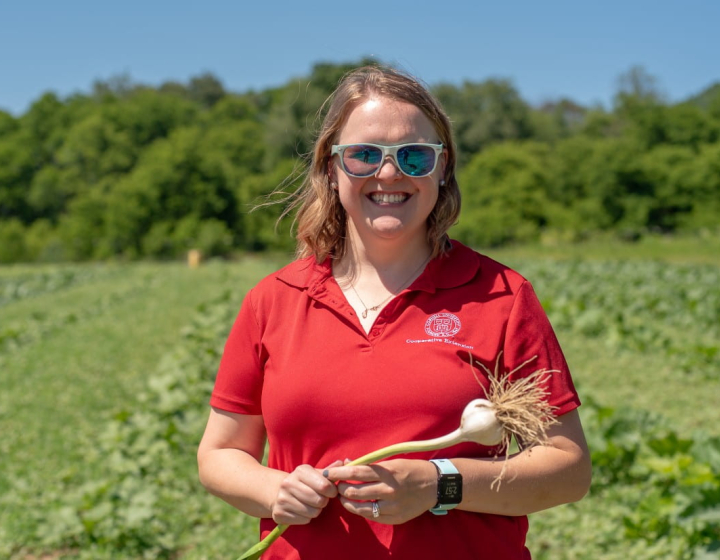Pet’s quality of life drives owner decision-making in emergency situations
Veterinarians conducted a study of 132 cases seen at the Cornell University Hospital for Animals (CUHA) emergency room to better understand how pet owners make decisions when their dogs need emergency care due to nontraumatic hemoabdomen — bleeding in the abdomen without a known cause. Their results showed that the pet’s quality of life was the most important factor to owners when it came to deciding between surgery, palliative care or euthanasia.
The study, published in the Journal of the American Veterinary Medical Association, was led by first author Jenna Menard, D.V.M. ’23, who was a veterinary student working in the hospital at the time. Menard partnered with Skylar Sylvester ’14, D.V.M. ’18, assistant clinical professor in the Section of Medical Oncology, and Daniel Lopez ’12, D.V.M. ’16, assistant clinical professor in the Section of Small Animal Surgery.
The results were unexpected, said Sylvester. “We thought that cost-benefit, such as finances and potential for a cancer diagnosis, would be the most important factors, but we found that quality of life was the primary driver of decision-making among owners,” she said.
The authors hope that this study will help guide conversations between veterinarians and owners as well as inform veterinary students about how to have difficult conversations — particularly around the challenges of hemoabdomen cases. Such cases are fairly common; according to the study, the hospital saw on average 60 cases a year over seven years.
“As a new graduate veterinarian, I know I will use this information to face what is often a daunting and emotional situation for both owners and veterinarians, and I hope others can do the same,” Menard said.
When dogs are suffering from nontraumatic hemoabdomen, about 25% of the time, the bleeding is due to disease that can be addressed with surgery alone. In the other 75% of cases, however, it is a cancerous tumor causing the spleen to bleed. While surgery can often stop the bleeding, it cannot cure the cancer. There’s currently no way to know which category the animal falls into without surgery. Consequently, there are many factors for an owner to consider when faced with this situation.
In addition to quality of life being weighted the highest, the authors found that owners also considered the risk of malignant cancer with a poor prognosis as well as the estimated time remaining with their pets. Financial considerations were among the least important. Moreover, owners in the study perceived that the quality of life was better on average for dogs who underwent surgery compared to those discharged with palliative care.
“We wanted to compile evidence-based data to inform owners what to expect following surgery to help them determine if they are putting their dog through too much,” said Lopez, who also completed a residency in small animal surgery at Cornell. “The data says, in most cases, you are helping these dogs return to a good quality of life, even if that time is limited because of an underlying cancer with a poor long-term prognosis. However, complications can occur that challenge this average, and it remains important to inform our owners about all possible outcomes, not just the average.”
The results of the study have sparked another line of inquiry for Sylvester, who is continuing to work on identifying better treatment options for dogs with splenic hemangiosarcoma, the most common malignant cancer causing hemoabdomen, as well working to develop a blood test to detect hemangiosarcoma. Sylvester, who works in medical oncology at Cornell, where she also completed her residency, is collaborating with Dr. Roy Cohen, research assistant professor at the Baker Institute for Animal Health, and Dr. Scott Coonrod, the Judy Wilpon Professor of Cancer Biology, to develop a diagnostic test for canine hemangiosarcoma using microRNA biomarkers, small pieces of genetic material typically present in the blood stream of cancer patients. This research is funded by the Cornell Richard P. Riney Canine Health Center.
“The goal is to one day be able to diagnose this disease with a bedside blood test,” Sylvester said. This will give owners an additional piece of information to help guide their care decisions if faced with the difficult situation of their dog having a hemoabdomen.
For now, the results of the team’s hemoabdomen study will give both veterinarians and owners more information to make the best choice for their dog.
“When we tell owners this [hemoabdomen] diagnosis, it’s emotionally distressing,” Lopez said. “They will often ask, ‘What would you do if it were your dog?’ Now we have some data to say, here’s how owners who made this decision before felt about their choice.”
Written by Sheri Hall and Melanie Greaver Cordova





